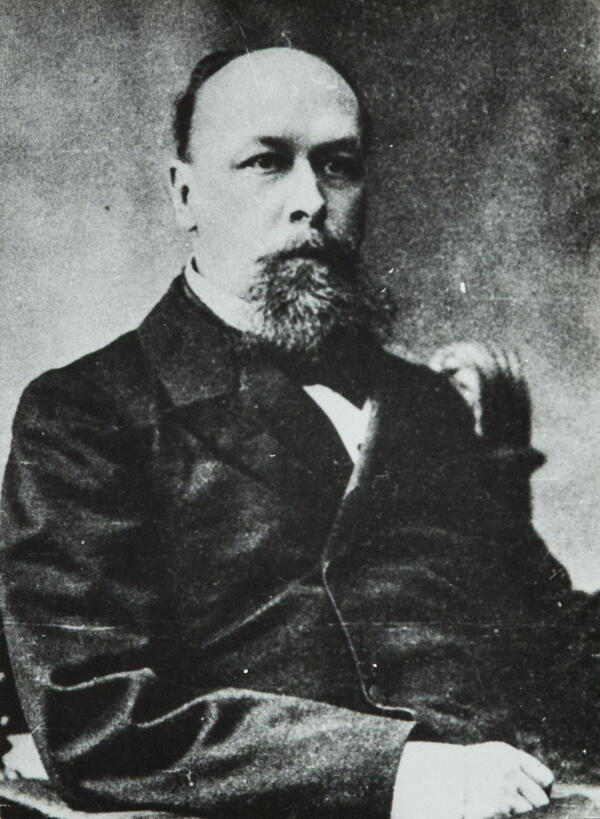Vsevolod Miller was an outstanding Russian researcher: he was a scholor of Sanskrit, mythology, Iran, Ossetiar, and the Caucasus, in addition to being an ethnographic-folklorist. His research played a major role in the development of Ossetian studies, and his works raised up entire generations of Ossetian intellectuals.
Miller received his secondary education at the Ennes Boarding School, and after graduating in 1865, he entered the history and philology faculty at Moscow University. At the university, he studied the history of the peoples of the East and Eastern folklore, the Greek and Latin languages, and Sanskrit. Vsevolod Fyodorovich’s first scientific work was a student’s test essay ‘Eastern and Western Relatives of a Russian Fairy Tale’, in which he tried to investigate the reasons for the similarities between a number of Slavic and Eastern fairy tales. In 1876, after graduating from the university, Miller published the research paper ‘Essays on Aryan Mythology (Aswina-Dioscuri)’ and defended it as his master’s thesis.
In his research, Miller sought a link between the Slavic Indo-European and Indo-Iranian folklore strata. This is how the researcher became interested in the history and culture of the Caucasian peoples, in particular the Ossetians. He made several ethnographic trips, as a result of which he published two volumes of “Ossetian Studies”. The scientist presented them as his dissertation for his doctorate degree in comparative linguistics.
For the third part of his Ossetian studies, Miller was awarded the Grand Gold Medal of the Imperial Russian Geographical Society, awarded in 1887. The author wrote about his work: “What fate drove the Ossetians to their current places of settlement, what memories they kept of their past? What is their way of life, what are their religious beliefs, what is the place of their language in the group of Iranian languages, what are the works of Ossetian poetry? These are the questions that we tried to answer as much as possible”.
At the turn of the 19th and 20th centuries, Miller discovered a new and fruitful stage in the history of Russian academic Caucasian studies. His works were devoted to the most important problems of history, archeology, ethnography, religion, epigraphy, linguistics, and oral folk poetry of the peoples of the North Caucasus.
For thirty years, Miller was in charge of the Dashkovsky Ethnographic Museum, which under his leadership conducted thorough work on collecting ethnographic material in the Caucasus, in particular in Ossetia. The museum’s storerooms were replenished with many articles of Ossetian life: utensils and furniture, clothes and national dresses, musical and household instruments.
Miller also collaborated with the Moscow Archaeological Society. For example, he organized a large archaeological expedition to Ossetia in order to study tower structures, graves, monuments, and crypts, and medieval churches. During the trip, he also recorded folk traditions in the Kurtatinskiy, Alagirskiy and Digorskiy gorges and collected materials about the Ossetians' religious beliefs.
Miller received his secondary education at the Ennes Boarding School, and after graduating in 1865, he entered the history and philology faculty at Moscow University. At the university, he studied the history of the peoples of the East and Eastern folklore, the Greek and Latin languages, and Sanskrit. Vsevolod Fyodorovich’s first scientific work was a student’s test essay ‘Eastern and Western Relatives of a Russian Fairy Tale’, in which he tried to investigate the reasons for the similarities between a number of Slavic and Eastern fairy tales. In 1876, after graduating from the university, Miller published the research paper ‘Essays on Aryan Mythology (Aswina-Dioscuri)’ and defended it as his master’s thesis.
In his research, Miller sought a link between the Slavic Indo-European and Indo-Iranian folklore strata. This is how the researcher became interested in the history and culture of the Caucasian peoples, in particular the Ossetians. He made several ethnographic trips, as a result of which he published two volumes of “Ossetian Studies”. The scientist presented them as his dissertation for his doctorate degree in comparative linguistics.
For the third part of his Ossetian studies, Miller was awarded the Grand Gold Medal of the Imperial Russian Geographical Society, awarded in 1887. The author wrote about his work: “What fate drove the Ossetians to their current places of settlement, what memories they kept of their past? What is their way of life, what are their religious beliefs, what is the place of their language in the group of Iranian languages, what are the works of Ossetian poetry? These are the questions that we tried to answer as much as possible”.
At the turn of the 19th and 20th centuries, Miller discovered a new and fruitful stage in the history of Russian academic Caucasian studies. His works were devoted to the most important problems of history, archeology, ethnography, religion, epigraphy, linguistics, and oral folk poetry of the peoples of the North Caucasus.
For thirty years, Miller was in charge of the Dashkovsky Ethnographic Museum, which under his leadership conducted thorough work on collecting ethnographic material in the Caucasus, in particular in Ossetia. The museum’s storerooms were replenished with many articles of Ossetian life: utensils and furniture, clothes and national dresses, musical and household instruments.
Miller also collaborated with the Moscow Archaeological Society. For example, he organized a large archaeological expedition to Ossetia in order to study tower structures, graves, monuments, and crypts, and medieval churches. During the trip, he also recorded folk traditions in the Kurtatinskiy, Alagirskiy and Digorskiy gorges and collected materials about the Ossetians' religious beliefs.



